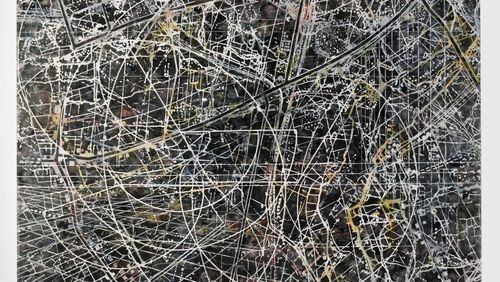ART REVIEW
“Cheryl Goldsleger: Recent Works”
Through Oct. 22. 11 a.m.-5 p.m. Tuesdays-Fridays; noon-5 p.m. Saturdays. Free. Sandler Hudson Gallery, 1000 Marietta St. N.W., Atlanta. 404-817-3300, www.sandlerhudson.com.
Bottom line: Work that hovers between abstraction and representation and somehow conveys the chaos of our times.
Athens artist Cheryl Goldsleger's most recent works, on view at Sandler Hudson Gallery, often suggest military surveillance or satellite images with their aerial view of landscapes. Those landscapes are then overlaid with grids and circles that can suggest a gun's crosshairs, a bull's-eye, map coordinates or topography markings.
This well-regarded artist, whose work appears in the collections of the Museum of Modern Art and the High Museum of Art among others, has often created artwork interested in exploring space in her studies of architecture or in her paintings of labyrinths and mazes.
Goldsleger’s paintings in “Recent Works” most often evoke maps, consisting of marks suggesting roadways or rivers, curved lines reminiscent of coastlines, clusters of white squares like houses set against dark ground and the ordered, quiltlike look of the urban landscape seen from far above. The complicating factor is the strange graphic lines superimposed on those suggestive landscapes. They can suggest gun sights but also map markings, coordinates, or some ordering vision.
Though this work is inspired by maps, Goldsleger seems most interested in psychological ideas of space rather than actual locations. Indeed, her images unleash a powerful feeling that surveillance photos can often give, of both mastery of a view and a powerful, God’s eye perspective, but also a sense of helplessness in being presented with such simultaneously comprehensive and detached information.
She also seems interested in expressing a perspective that is part of our contemporary sensibility — a feeling of omniscience mixed with a feeling of chaos inspired by our global vantage of 24/7 news and the vast, overwhelming waves of information that inundate us. It’s a feeling we have all perhaps had at one time or another, a feeling of being all-knowing but also utterly dwarfed and cowed by our puniness in the enormous scheme of things.
The work seems to be about how we order and make sense of the world: Those organizing lines in grids and circles overlaid over the landscapes suggest our desire for control.
Up close the works are abstract and painterly, like the weave of a fabric, but far away they feel structured and coherent, something that seems analogous to our own experience of losing insight when things are immediately under our noses, and gaining it when we can observe from a distant, controlling vantage. It’s a metaphor for human experience and perception, that when we are close to something, we often can’t see it, and when we are far away, it falls into shape and order.
Though some of Goldsleger’s smaller works in shades of gray look like drawings, instead they are more akin to watercolors, created by mixing graphite and water to create a gray wash in varying degrees of lightness and darkness. In “Impartial” in graphite and mixed media, we hover above what looks like an urban landscape of clusters of illuminated buildings in tight formations and undulating streets weaving through the landscape. That landscape is overlaid with white lines that divide the view into maplike quadrants.
Larger works, like “Indeterminate,” with their soft bursts of pale yellows and pinks dotting the landscape suggesting flickers of light or activity, are also created with a blend of graphite and paints Goldsleger makes herself.
There is an ethereal quality to the works, and an undeniable quality the artist describes of getting lost in the work, falling into these vast metaphysical spaces.






